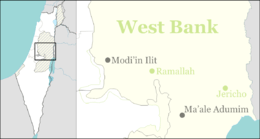Halamish
| Halamish | |
|---|---|
|
| |
 Halamish | |
| Coordinates: 32°0′29.07″N 35°7′37.98″E / 32.0080750°N 35.1272167°ECoordinates: 32°0′29.07″N 35°7′37.98″E / 32.0080750°N 35.1272167°E | |
| District | Judea and Samaria Area |
| Council | Mateh Binyamin |
| Region | West Bank |
| Affiliation | Amana |
| Founded | 1 November 1977 |
| Founded by | Gush Emunim |
| Population (2017)[1] | 1,314 |
| Website | Neve Tzuf Halamish |
Halamish (Hebrew: חַלָּמִישׁ. lit. Flint), also known as Neveh Tzuf (Hebrew: נווה צוף, lit. Oasis of Nectar), is an Israeli settlement in the Judea and Samaria administrative area of the West Bank, located in the southwestern Samarian hills to the north of Ramallah, 10.7 kilometers east of the Green line. The Orthodox Jewish community was established in 1977. It is organised as a community settlement and falls under the jurisdiction of Mateh Binyamin Regional Council. In 2017 it had a population of 1,314.
The settlement of Neveh Tzuf is home to the religious pre-army Mechina Elisha.[2]
The international community considers Israeli settlements illegal under international law, but the Israeli government disputes this.[3]
History
On 16 October 1977, two groups of settlers, one religious, calling itself “Neveh Tzuf” and one secular, called “Neveh Tzelah” with a total of 40 families moved into the abandoned former British Tegart fort building near the Palestinian village Nabi Salih.[4]
The original name of the settlement, Neveh Tzuf, was rejected by the Government Naming Committee, arguing that it might be misleading since the biblical location, Eretz Tzuf, was elsewhere. The naming committee gave the new settlement the official name 'Halamish' instead, and since this was rejected by the settlers, both names are used for the settlement.[4]
On 21 July 2017, three Israelis were killed and one severely wounded in a stabbing attack in Halamish.[5]
Legal status
Upon the first work preparing the land, residents of the nearby Palestinian village Deir Nidham went to the Supreme Court of Israel and claimed ownership of the Havlata Hill, which is now in the centre of Halamish. Based on aerial photos from the turn of the 20th century, showing the disputed land to be barren, and Ottoman Empire land law specifying that land not worked for over ten years becomes state land, the land on that hill was declared state land and freed for settlement constructions. This court ruling became the precedent for future land ownership disputes.[6]
The residents of the nearby Palestinian village of Nabi Salih regularly protest against what they allege is the takeover of a spring by the settlers of Halamish' however, the spring was declared an "antiquities site" by the Civil Administration; it which is located on private land belonging to inhabitants of Nabi Salih. Residents of Nabi Salih also assert that they are being prevented from working the fields around the spring.[7] The protests have led to violent clashes, with Palestinian youths throwing stones and Israeli forces firing on protesters with tear gas, rubber bullets, and water cannons.[8] Since the end of 2009, 64 people (13% of the village's population) has been arrested by Israeli forces.[9] Bassem al-Tamimi, one of the leaders of the protests, who was declared a human rights defender by the European Union and a prisoner of conscience by Amnesty International, has been arrested twelve times to date.[8] On 24 March 2011 he was arrested and charged with incitement, holding a march without a permit, sending youths to throw stones, and perverting the course of justice.[10] After an 11-month military trial, he was cleared of the central charge of incitement and of perverting the course of justice by an Israeli military court, but found guilty of taking part in illegal demonstrations and of soliciting protesters to throw stones largely based on the testimony of two Palestinian youths aged 14 and 15.[8][10] After being released on bail on 24 April 2012,[10] he was given a 13-month sentence in May 2012, corresponding to the time he had served in prison while awaiting trial.[11]
According to ARIJ, the southern part of Halamish is built on land Israel confiscated from the Palestinian town of Al-Ittihad,[12] while 604 dunums of land was confiscated from the Palestinian village of Deir Nidham for the construction of Halamish.[13]
References
- ↑ "List of localities, in Alphabetical order" (PDF). Israel Central Bureau of Statistics. Retrieved August 26, 2018.
- ↑ "Mechinot". Jewish Agency. Retrieved 31 March 2011.
- ↑ "The Geneva Convention". BBC. 2009-12-10.
- 1 2 Hoberman, Haggai (2008). Keneged Kol HaSikuim [Against All Odds] (in Hebrew) (1st ed.). Sifriat Netzarim.
- ↑ IDF raids Halamish terrorist’s home, arrests his brother Times of Israel, 22 July 2017
- ↑ Hoberman, Haggai (2008). Keneged Kol HaSikuim [Against All Odds] (in Hebrew) (1st ed.). Sifriat Netzarim. p. 169.
- ↑ Gideon Levy (22 April 2010). "A spa for Samaria. Every Friday, villagers demonstrate against the excavation of the spring". Haaretz. Retrieved 31 March 2011.
- 1 2 3 Harriet Sherwood (20 May 2012). "Palestinian protester cleared of incitement charge". The Guardian. Retrieved 20 May 2012.
- ↑ Amira Hass (28 March 2011). "Mighty Israel and its quest to quash Palestinian popular protest". Haaretz. Retrieved 20 May 2012.
- 1 2 3 Steve Weizman (20 May 2012). "West Bank activist Tamimi convicted of stoning charge". Google News. Agence France-Presse. Retrieved 20 May 2012.
- ↑ The Associated Press (29 May 2012). "Palestinian protest leader walks free". The Times of Israel. Retrieved 9 March 2013.
- ↑ Al-Itihad Town Profile (Beitillu, Jammala & Deir 'Ammar), ARIJ, pp. 16-17
- ↑ Deir Nidham village profile, ARIJ, p. 16
External links
| Wikimedia Commons has media related to Halamish. |